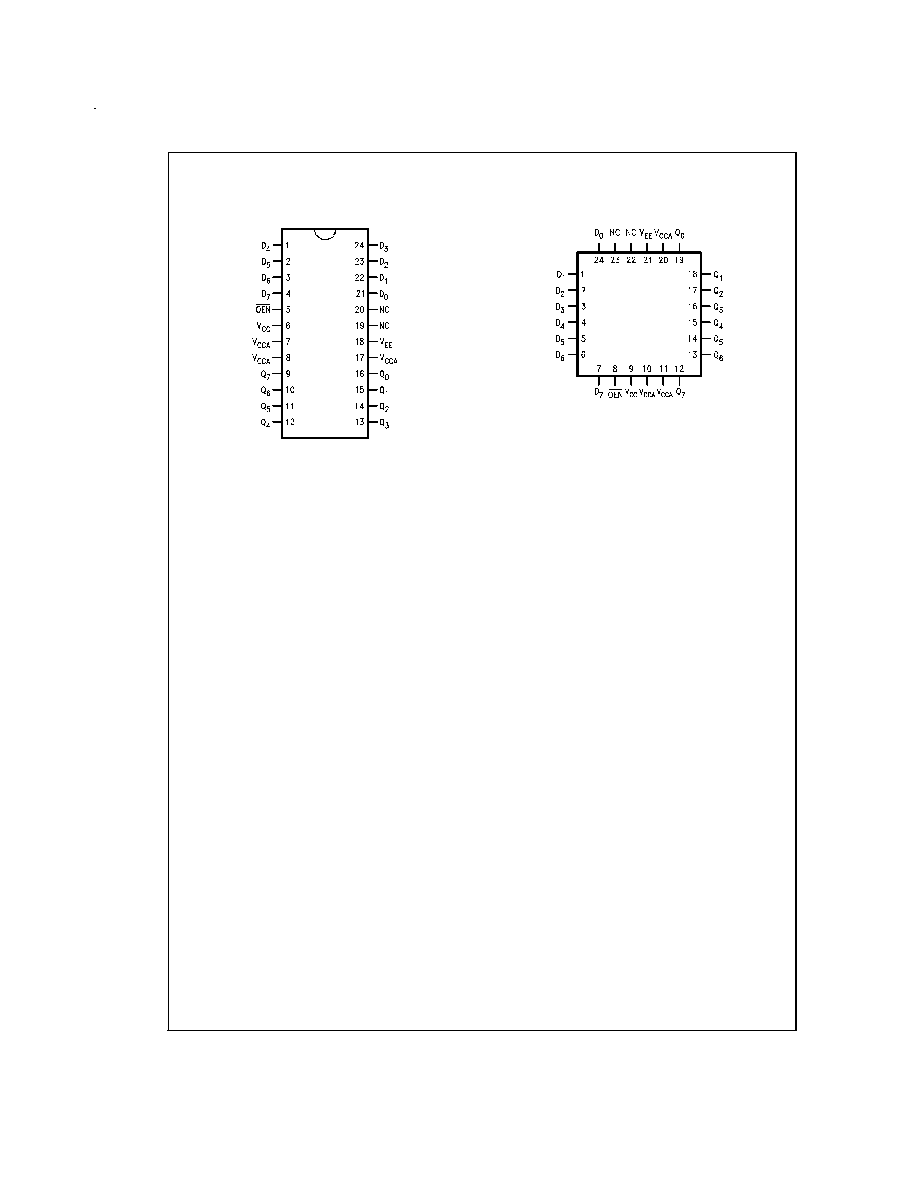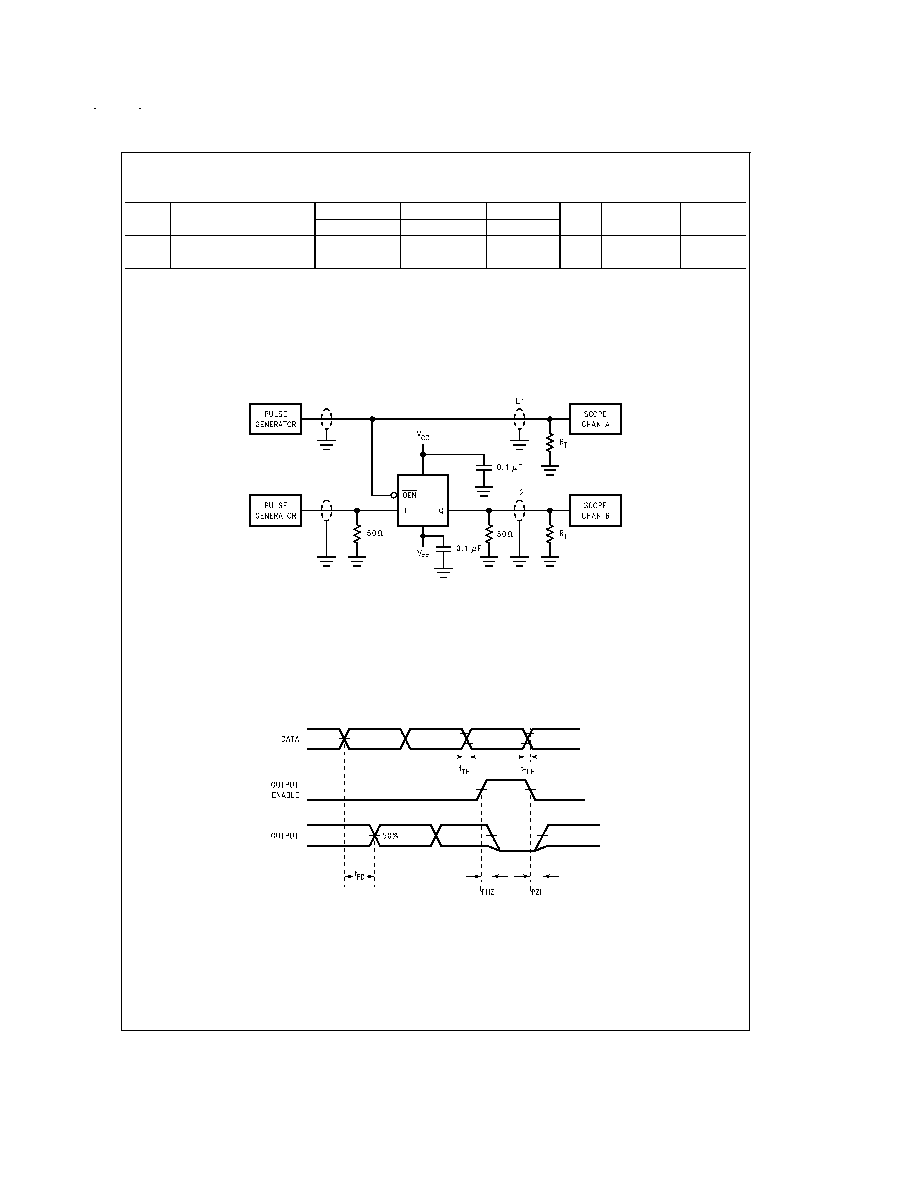 | –≠–ª–µ–∫—Ç—Ä–æ–Ω–Ω—ã–π –∫–æ–º–ø–æ–Ω–µ–Ω—Ç: 100352DC | –°–∫–∞—á–∞—Ç—å:  PDF PDF  ZIP ZIP |

100352
Low Power 8-Bit Buffer with Cut-Off Drivers
General Description
The 100352 contains an 8-bit buffer, individual inputs (Dn),
outputs (Qn), and a data output enable pin (OEN). A Q out-
put follows its D input when the OEN pin is LOW. A HIGH on
OEN holds the outputs in a cut-off state. The cut-off state is
designed to be more negative than a normal ECL LOW level.
This allows the output emitter-followers to turn off when the
termination supply is -2.0V, presenting a high impedance to
the data bus. This high impedance reduces termination
power and prevents loss of low state noise margin when sev-
eral loads share the bus.
The 100352 outputs are designed to drive a doubly termi-
nated 50
transmission line (25
load impedance). All in-
puts have 50 k
pull-down resistors.
Features
n
Cut-off drivers
n
Drives 25
load
n
Low power operation
n
2000V ESD protection
n
Voltage compensated operating range = -4.2V to -5.7V
n
Available to industrial grade temperature range
n
Available to MIL-STD-883
Logic Symbol
Pin Names
Description
D
0
≠D
7
Data Inputs
OEN
Output Enable Input
Q
0
≠Q
7
Data Outputs
NC
No Connect
DS100296-1
August 1998
100352
Low
Power
8-Bit
Buffer
with
Cut-Off
Drivers
© 1998 National Semiconductor Corporation
DS100296
www.national.com

Connection Diagrams
24-Pin DIP
DS100296-2
24-Pin Quad Cerpak
DS100296-3
www.national.com
2

Logic Diagram
Truth Table
Inputs
Outputs
Dn
OEN
Qn
L
L
L
H
L
H
X
H
Cutoff
H = HIGH Voltage Level
L = LOW Voltage Level
Cutoff = Lower-than-LOW State
X = Don't Care
DS100296-5
www.national.com
3

Absolute Maximum Ratings
(Note 1)
If Military/Aerospace specified devices are required,
please contact the National Semiconductor Sales Office/
Distributors for availability and specifications.
Above which the useful life may be impaired
Storage Temperature (T
STG
)
-65∞C to +150∞C
Maximum Junction Temperature (T
J
)
Ceramic
+175∞C
V
EE
Pin Potential to
Ground Pin
-7.0V to +0.5V
Input Voltage (DC)
V
EE
to +0.5V
Output Current (DC Output HIGH)
-100 mA
ESD (Note 2)
2000V
Recommended Operating
Conditions
Case Temperature (T
C
)
Military
-55∞C to +125∞C
Supply Voltage (V
EE
)
-5.7V to -4.2V
Note 1: Absolute maximum ratings are those values beyond which the de-
vice may be damaged or have its useful life impaired. Functional operation
under these conditions is not implied.
Note 2: ESD testing conforms to MIL-STD-883, Method 3015.
Military Version
DC Electrical Characteristics
V
EE
= -4.2V to -5.7V, V
CC
= V
CCA
= GND, T
C
= -55∞C to +125∞C
Symbol
Parameter
Min
Max
Units
T
C
Conditions
Notes
V
OH
Output HIGH Voltage
-1025
-870
mV
0∞C to +125∞C
V
IN
= V
IH(Max)
or V
IL(Min)
Loading
with
25
to
-2.0V
(Notes 3,
4, 5)
-1085
-870
mV
-55∞C
V
OL
Output LOW Voltage
-1830
-1620
mV
0∞C to +125∞C
-1830
-1555
mV
-55∞C
V
OHC
Output HIGH Voltage
-1035
mV
0∞C to +125∞C
V
IN
= V
IH(Min)
or V
IL(Max)
Loading
with
25
to
-2.0V
(Notes 3,
4, 5)
-1085
mV
-55∞C
V
OLC
Output LOW Voltage
-1610
mV
0∞C to +125∞C
-1555
mV
-55∞C
V
OLZ
Cut-Off LOW Voltage
-1950
mV
0∞C to +125∞C
V
IN
= V
IH(Min),
or
V
IL(Max)
OEN
=HIGH
(Notes 3,
4, 5)
-1850
-55∞C
V
IH
Input HIGH Voltage
-1165
-870
mV
-55∞C to +125∞C
Guaranteed HIGH signal
1, 2, 3, 4
for All inputs
V
IL
Input LOW Voltage
-1830
-1475
mV
-55∞C to +125∞C
Guaranteed LOW signal
for All inputs
(Notes 3,
4, 5, 6)
I
IL
Input LOW Current
0.50
µA
-55∞C to +125∞C
V
EE
= 4.2V
(Notes 3,
4, 5)
V
IN
= V
IL(Min)
I
IH
Input HIGH Current
240
µA
0∞C to + 125∞C
V
EE
= -5.7V
(Notes 3,
4, 5)
340
µA
-55∞C
V
IN
= V
IH(Max)
I
EE
Power Supply Current
-55∞C to +125∞C
Inputs Open
(Notes 3,
4, 5)
-145
-55
mA
V
EE
= -4.2V to -4.8V
-150
V
EE
= -4.2V to -5.7V
Note 3: F100K 300 Series cold temperature testing is performed by temperature soaking (to guarantee junction temperature equals -55∞C), then testing immediately
without allowing for the junction temperature to stabilize due to heat dissipation after power-up. This provides "cold start" specs which can be considered a worst case
condition at cold temperatures.
Note 4: Screen tested 100% on each device at -55∞C, +25∞C, and +125∞C, Subgroups 1, 2, 3, 7, and 8.
Note 5: Sample tested (Method 5005, Table I) on each manufactured lot at -55∞C, +25∞C, and +125∞C, Subgroups A1, 2, 3, 7, and 8.
Note 6: Guaranteed by applying specified input condition and testing V
OH
/V
OL
.
AC Electrical Characteristics
V
EE
= -4.2V to -5.7V, V
CC
= V
CCA
= GND
Symbol
Parameter
T
C
= -55∞C
T
C
= +25∞C
T
C
+125∞C
Units
Conditions
Notes
Min
Max
Min
Max
Min
Max
t
PLH
Propagation Delay
0.30
2.60
0.50
2.40
0.50
2.70
ns
Figures 1, 2
(Notes 7,
8, 10, 11)
t
PHL
Dn to Output
t
PZH
Propagation Delay
1.20
4.40
1.40
4.20
1.20
4.40
ns
Figures 1, 2
(Notes 7,
8, 9, 11)
t
PHZ
OEN to Output
0.70
3.00
0.70
2.80
0.70
3.20
www.national.com
4

AC Electrical Characteristics
(Continued)
V
EE
= -4.2V to -5.7V, V
CC
= V
CCA
= GND
Symbol
Parameter
T
C
= -55∞C
T
C
= +25∞C
T
C
+125∞C
Units
Conditions
Notes
Min
Max
Min
Max
Min
Max
t
TLH
Transition Time
0.40
2.50
0.40
2.40
0.40
2.70
ns
Figures 1, 2
(Note 10)
t
THL
20% to 80%, 80% to 20%
Note 7: F100K 300 Series cold temperature testing is performed by temperature soaking (to guarantee junction temperature equals -55∞C), then testing immediately
after power-up. This provides "cold start" specs which can be considered a worst case condition at cold temperatures.
Note 8: Screen tested 100% on each device at +25∞C temperature only, Subgroup A9.
Note 9: Sample tested (Method 5005, Table I) on each manufactured lot at +25∞C, Subgroup A9, and at +125∞C and -55∞C temperatures, Subgroups A10 and A11.
Note 10: Not tested at +25∞C, +125∞C, and -55∞C temperature (design characterization data).
Note 11: The propagation delay specified is for single output switching. Delays may vary up to 300 ps with multiple outputs switching.
Test Circuitry
Switching Waveforms
DS100296-6
Notes:
V
CC
, V
CCA
= +2V, V
EE
= -2.5V
L1 and L2 = equal length 50
impedance lines
R
T
= 50
terminator internal to scope
Decoupling 0.1 µF from GND to V
CC
and V
EE
All unused outputs are loaded with 25
to GND
C
L
= Fixture and stray capacitance
3 pF
FIGURE 1. AC Test Circuit
DS100296-7
Note:
The output AC measurement point for cut-off propagation delay
testing = the 50% voltage point between active V
OL
and V
OH
.
FIGURE 2. Propagation Delay, Cut-Off and Transition Times
www.national.com
5




